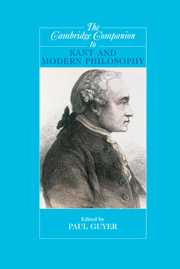Book contents
- Frontmatter
- Introduction: The starry heavens and the moral law
- 1 “A Priori”
- 2 Kant on the perception of space (and time)
- 3 Kant’s philosophy of mathematics
- 4 Kant on a priori concepts: The metaphysical deduction of the categories
- 5 Kant’s philosophy of the cognitive mind
- 6 Kant’s proofs of substance and causation
- 7 Kant and transcendental arguments
- 8 The critique of metaphysics: The structure and fate of Kant’s dialectic
- 9 Philosophy of natural science
- 10 The supreme principle of morality
- 11 Kant on freedom of the will
- 12 Mine and thine? The Kantian state
- 13 Kant on sex and marriage right
- 14 Kant’s theory of peace
- 15 Kant’s conception of virtue
- 16 Kant’s ambitions in the third Critique
- 17 Moral faith and the highest good
- 18 Kant’s critical philosophy and its reception - the first five years (1781-1786)
- Bibliography
- Index
2 - Kant on the perception of space (and time)
Published online by Cambridge University Press: 28 March 2007
- Frontmatter
- Introduction: The starry heavens and the moral law
- 1 “A Priori”
- 2 Kant on the perception of space (and time)
- 3 Kant’s philosophy of mathematics
- 4 Kant on a priori concepts: The metaphysical deduction of the categories
- 5 Kant’s philosophy of the cognitive mind
- 6 Kant’s proofs of substance and causation
- 7 Kant and transcendental arguments
- 8 The critique of metaphysics: The structure and fate of Kant’s dialectic
- 9 Philosophy of natural science
- 10 The supreme principle of morality
- 11 Kant on freedom of the will
- 12 Mine and thine? The Kantian state
- 13 Kant on sex and marriage right
- 14 Kant’s theory of peace
- 15 Kant’s conception of virtue
- 16 Kant’s ambitions in the third Critique
- 17 Moral faith and the highest good
- 18 Kant’s critical philosophy and its reception - the first five years (1781-1786)
- Bibliography
- Index
Summary
Although the “Transcendental Aesthetic” is the briefest part of the first Critique, it has garnered a lion's share of discussion. This fact reflects the important implications that Kant drew from his arguments there. He used the arguments concerning space and time to display examples of synthetic a priori cognition, to secure his division between intuitions and concepts, and to support transcendental idealism. Earlier, in the years around 1770, Kant's investigations into space and time had facilitated his turn toward “critical” philosophy. Prior to that time, Kant's main interests in space and time pertained to physics and metaphysics. As he entered the critical period, he delved into the cognitive basis of our experience of space (and time), and drew his conclusions about their ideality.
Kant's doctrines of space and time provoked extensive response in his own time and throughout the nineteenth century. These responses variously concerned the metaphysics, physics, epistemology, psychology, and geometry of space. Throughout the nineteenth century, philosophers, physiologists, and psychologists sought to extend or to refute Kant's theories of space. By the last decades of the nineteenth century, many had rightly concluded that the existence of non-Euclidean geometry as a candidate description of physical space refuted Kant's full doctrine of space - though some have hoped that his position might be saved by restricting it to “visual space.”
- Type
- Chapter
- Information
- The Cambridge Companion to Kant and Modern Philosophy , pp. 61 - 93Publisher: Cambridge University PressPrint publication year: 2006
- 29
- Cited by



